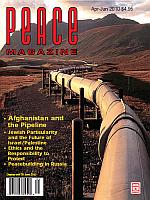
Peace Magazine Apr-Jun 2010, page 6. Some rights reserved.
Search for other articles by Mark Walsh here
Some approaches to peacebuilding are cerebral. Others have an emotional element or take account of cultural contexts. All these are good -- but they are incomplete if the body is ignored.
People are embodied. Think of the last time you were in a dispute. Your heart rate and breathing rate increased and your muscles tightened. This “flight or fight” response may have been adaptive for our evolutionary ancestors but it reduces our logical thinking and empathic connection. We may say and do things that we regret later. A friend of mine in the prison service says that he likes working with murderers best, for “they are just nice ordinary people who lost it once.” Whether we murder people or not, under stress we all have an unpleasant contraction and twisting of the body and narrowing of the attention. This hinders us, physically derailing our empathic resosurces.
Some feelings—moods—last a while. A mood as a transparent physical disposition for action. We see the world “through” our moods. I have one friend who would complain even if she won the lottery and another one who sees the bright side even at funerals. Each of them has a persistent underlying mood that lives in their bodies. If people are stuck in a mood of resentment for example they are unlikely to be effective in peace building.Fortunately, building even a small amount of awareness of mood can dramatically increase peacebuilding success.
Trauma lives in the body. War and other forms of conflict are written into the posture and movement of survivors. Having seen a group of Iraqi friends before and after the insurgency I was shocked by the differences in their bodies, although none of them had been directly physically harmed. Living in a war zone and seeing daily suffering had left its imprint. Whole communities often have these trauma responses which may manifest as postural imbalance, lack of feeling (embodied learned helplessness), apathy, or a hyper-sensitivity to stimuli.
Ability to read the feelings of others through the body makes a peacemaker more effective. We all make these bodily assessments unconsciously and instantaneously in any event, since 90 percent of emotional communication is non-verbal. Studying the body explicitly changes our vague intuition (which itself is bodily) into conscious awareness.
It is worth knowing how bodies influence each other. People unconsciously mimic one another; this is the basis of rapport and often helpful in conflict resolution. Unfortunately, however, if one person is perturbed, others will “mirror” his state, which may then be mirrored and amplified back, creating a negative feedback loop. It’s best to interrupt this downward spiral by relaxing and “centering.” This takes practice.
Compassion and love are actions done in the body. To experience this try tightening your jaw and fists and saying “I love you.” If you can do it at all, you will probably laugh at the inconsistency between your words and your body. I think that people in all cultures have an embodied nonviolent spirituality; they find aggressive acts disturbing—if they do feel their bodies. Only disembodiment makes violence possible.
With increased awareness one learns to pause, creating a gap between act and reaction where a peaceful choice may enter. A meditative practice — whether formal sitting meditation, yoga, martial arts, or simple mindful walking—can help peace builders to develop this gap,
Also, the physical environment can affect mood profoundly. In a sense the planet is our larger collective body. How we relate to our body plural is linked to the violence we do to our body singular (the planet).
This is not mere theory. Consider for example the Training Across Borders project. In April 2005, 100 people from conflicted countries gathered in the UN-controlled no-man’s-land that divides Cyprus. They lived together, attended workshops, discussed their conflicts, and practiced aikido intensely for five days. The non-competitive physical contact of aikido heightened their connection to a degree that could not be achieved through words alone. All those who considered themselves enemies became friends and some started projects in their home countries. I was one of the participants. Since learning about “embodied peacebuilding” in Cyprus I have been involved with projects in the favela slums of Brazil, in Ethiopia (removing weapons) and most recently in stress training in corporate settings. These days I rarely use aikido explicitly but rather the principles of the art.
Here are seven tips for using your body skillfully in peace building and conflict resolution:
1. ABC “centering” practice
If you are under pressure and needing to “get yourself together” then try ABC: Become Aware of you body, Balance your posture and attention and relax your Centre-line — especially your abdominals and jaw/tongue. This can be done silently in a few seconds without anyone noticing or a facilitator/mediator can spend a minute talking a group through the process.
2. Get things moving
When a negotiation is stuck take people for a walk to get things moving. Move yourself when you are stuck.
3. Be Aware of Trauma
Be on the look-out for embodied trauma responses for those who have been in conflict.
4. Mirroring
Use and interrupt bodily mirroring as appropriate.
5. Practice bodily assessments
Sit in a public place with a friend and practice looking at bodies together and making guesses about the people. If you can get feedback all the better!
6. Ask others to assess your mood
Gain awareness of the canvas upon which all your communication is painted.
7. Feel and get a body awareness practice
Feel your body during peacebuilding. Under pressure this will be hard but if you use your body regularly in a mindful manner many of the skills mentioned will start to come easily.
Mark Walsh leads Integration Training in Brighton and London, England with organizations and individuals. mark@integrationtraining.co.uk> He recommends Paul Linden’s e-books.

Peace Magazine Apr-Jun 2010, page 6. Some rights reserved.
Search for other articles by Mark Walsh here